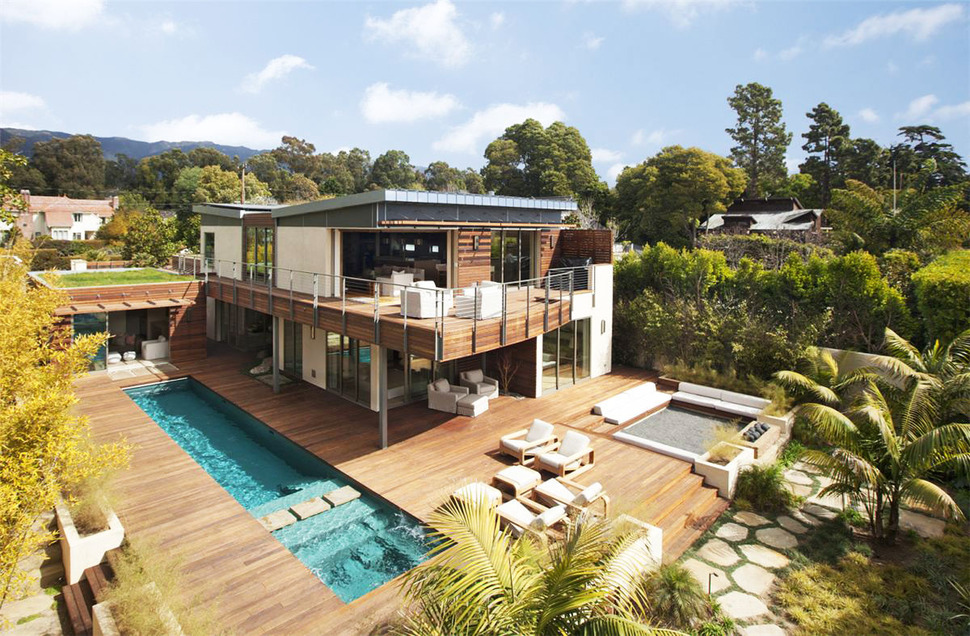Building a Home – 10 Steps to Building a Family House

Jonathan Segal’s Lemperle Residence – a Modern Dream Home
Building a home is very much a part of the American Dream, and the prospect is cause for excitement for those fortunate enough to be able carry it out. For most people, the fact that there’s a lot of hard work involved is usually a selling point, rather than a reason to reconsider.
Because so there are so many resources available for people just starting out, a lot of headache and expense can be saved by considering these new home tips before construction actually begins.
1. The Pre-Planning Stage When Building a New Home
The builder you choose is essential to minimizing future headaches. He or she should have a great grasp of the things to know before building a home, for starters.
This means you need someone who is verifiably reliable, has other properties that you can take a look at, has insurance and has several references that all pan out.
You simply cannot take too many precautions in this pre-planning stage, to make sure the person responsible for your dream home is reputable.
Once this is settled, there is much to consider both before and as you build your own home. Don’t feel overwhelmed, however, as it is a process, and there is allowance for change along the way.
[socialpoll id=”2402499″]
2. Building A Home For a Family Of….
Can you anticipate the intended size of your family? If so, make sure you’ve planned for the right number of rooms. Indeed; consider the likelihood of building extra rooms later, for any welcome but unplanned surprises.
If it’s within your budget, for example, a pool could be a consideration as the kids get older – or even when they’re young, to learn how to swim. Many newbie home builders can’t wait to play out the family barbecues by the pool they’ve envisioned, so a pool area serves multiple purposes.
While we’re on the subject of barbecues, it doesn’t hurt to allocate room for extra fire escapes, on the safety side. No matter how sturdy the roof of the new house will be, the better the slant, the less likely there will be any leaks in the future. Furthermore, pools of water won’t ever get a chance to collect and grow stagnant, inviting decay of the timber and tiling.

3. Location, Location, Location

Scout every aspect of the neighborhood, from school district placement, to any intended construction in the area. Is there the slightest chance that the region down the street gets turned into a thru-way to another town or city? Something like this would invite unplanned noise into the neighborhood, and it would have been nice to know this beforehand.
Where is shopping located? Is it centrally placed for ease-of-access, and are there neighborhood shuttles for transit of residents to the mall? Things do change that you can’t control, so focus on the things you have a reasonable expectation of controlling.
4. New Home Amenities: Why Not Get a Walk-In Shower?
 Plan for your later years. When you’re just starting out in your new home, building walk-in showers may not seem necessary.
Plan for your later years. When you’re just starting out in your new home, building walk-in showers may not seem necessary.
But in case of injury (possibly) or age (definitely), such simple amendments could could be godsends later on.
Have at least one shower be designed for ease of access; although two are better of you’ve got the kind of his-and-hers setup that’s common in higher-end homes.
Walk-in showers also give the appearance of more space in the bathroom, and certainly provide more walking room in the general area outside.
Besides, even the young can slip and fall, so handles and level ground are benefits that needn’t wait until older age.
Additionally, the bathroom and kitchen are two of the most valuable rooms in a home, and really improve future selling prospects to high-end bidders.
You’ll enjoy the extra space and appearance for years to come, and fetch a great return on the investment if you’re ever ready to sell. Basically, how to erect the bathroom you want is one of the things to know before building a home.
[socialpoll id=”2402503″]
5. New Homes and Upgrades
 Ascertain the prices of any intended upgrades, so that they don’t devalue too much if you choose to sell the home – after all, many homes are sold right after they’re built, for various reasons.
Ascertain the prices of any intended upgrades, so that they don’t devalue too much if you choose to sell the home – after all, many homes are sold right after they’re built, for various reasons.
Don’t spend too much money on something that has a good chance at being out-of-style or generally undesirable later on. The fact is, you can rarely be absolutely certain you’re going to keep the house.
Vanity amendments are many; try to stick with the ones that add value – or at least do not devalue. Of course, it’s your dream home you’re building, so if it’s always been a desire, then knock yourself out if it’s within budget.
In keeping with the above: although you should already have in mind the layout of the house, it is instructive to leave room for future upgrades.
This isn’t that difficult, as there are common additions almost any family would consider – just look around in home construction magazines – or just as well, online – to see what others are up to.
Forums can be a tremendous help when setting out to build a home, so use this resource.
[socialpoll id=”2402506″]
6. Understand the Local Irrigation System
Analyze the general placement and water systems of houses in the surrounding neighborhood.
You want to ensure you aren’t building in a spot where water will collect, or where there won’t be room for later expansion. Believe it or not, this is definitely one of the things to know before building a home.
It isn’t a desirable thing to have all your neighbor’s water collecting in your spot. Additionally, zoning restrictions should be understood.
7. Due Diligence With New Home Contracts

Pore over the building contract. At this early stage, it is even worth it to seek the services of an appropriate lawyer just to be sure of anything you don’t understand.
You can be sure that the cost of this will be minimal compared to the future headache if something goes awry.
Most contractors are reputable, but you don’t want to run into one of the very few that aren’t.
Of course, you could also just talk to the drafter about anything that seems obscure and get it hashed out to your satisfaction.
If you’ve already budgeted for the house and come to a figure you feel you can afford, lower this amount even further to account for unexpected tax hikes and increased mortgage rates.
You can’t lose with this approach – it all but ensures you won’t get caught in another avalanche of foreclosures during a mortgage tax hike.
8. Home Building and Property Value
In your investigation into the general neighborhood of your future home, search for signs of impending improvement in the residential area, so that the future property value of your home will be maximized.
9. Look Into the Homeowner’s Association (HOA)
Is the area you’re looking into controlled by a Homeowner’s Association or HOA? Become very familiar with their rules, such as those regarding property expansion and amendments.
You don’t want to have to pay any fees simply because of changes you were unaware were prohibited.

10. Conclusion or Just the Beginning?
These are the kinds of things that are necessary to streamline the process of building your new home, so that it can be as painless as possible, and be the dream you’ve always envisioned. There are plenty of resources to walk you through the phases; consider this a start.

